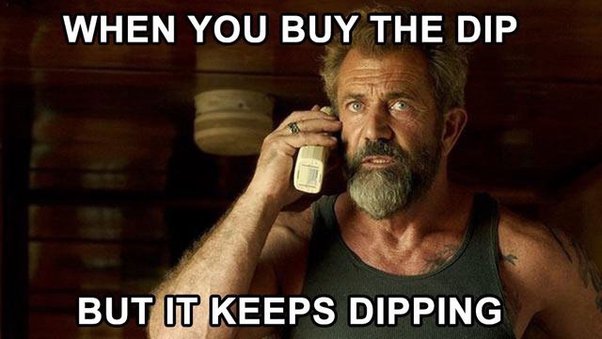One of the most common questions investors have is what to do when you buy the dip and it keeps dipping. Do you continue to add to your position? Do you hold or sell?
There is no clear answer on this subject since it depends a lot on the specific situation and what exactly you are buying. Let’s look at some of the different scenarios and understand whether you should continue to buy the dip, hold or just sell.
What if the dip keeps dipping?
When you buy the dip but the dip keeps dipping, you are pretty much limited to three choices:
- Continue to buy the dip
- Hold
- Sell
In order to decide what the best approach is under this type of situation you need to ask yourself a few questions:
- Has anything changed fundamentally?
- What is driving the stock lower?
- Who is selling?
- Is this a short, medium, or long-term investment?
Fundamental changes
One of the most important factors when it comes to deciding if you should continue to buy the dip is whether there has been a fundamental change in the company to justify its price decline. When the investment thesis for stock changes, that could be a selling signal.
The most simple way of analyzing fundamental changes, and deciding whether to sell your stock or not is to determine if these changes affect the investment thesis. This is one of the reasons why it is so important to keep an investing journal, where you can write down your trades and the thesis behind each of your investments.
When the thesis changes it is perhaps a good opportunity to sell. Try to focus on the reasons why you bought the stock in the first place. Evaluating fundamental changes could be challenging because you have to define exactly what kind of change can prompt you to sell.
What is driving the price?
Knowing exactly the reason behind why the price of a certain stock is declining, is also important. Maybe it is just recent news, that is not going to impact the company. Or perhaps it is a fundamental change, that will redefine the investment thesis.
If you understand the narrative behind the price fluctuations of stocks, you are able to filter through the noise. This allows you to make better decisions because you can distance yourself from the price action and make better decisions. Avoid panicking, and selling at a loss just because everyone else is selling. Sometimes unpredicted news can create a dip, but you never know exactly when it will reverse.
Who is selling the stock?
Another important part of this process is to try and consider who is selling the stock. Sometimes it is just retail investors panicking, or large institutional investors that are forced to close the position for compliance reasons.
The best indicator is to look at insider trading, as this tends to be one of the best indicators. If insiders are selling, it could signal that things are about to get even worst, and the dip will keep dipping.
Is this a short, medium, or long-term investment?
The investment horizon also affects how you should proceed when the dip keeps dipping. If you have a short-term horizon, and even if there are no drastic fundamental changes it might be better to sell the stock. With a medium or long-term investment, it might make sense to continue buying the dip.
When you should sell instead of keep buying the dip
If there are significant fundamental changes it is usually best to sell. If your initial investment thesis and risk-return profile change, it does not make sense to add to your position. Since the valuation of the company will be entirely different, it will not be reflected in the market value.
Cutting your losses can sometimes be painful, but it tends to be the best approach.
When you should hold instead of keep buying the dip
Some investors don’t consider holding when the dip keeps dipping, but in some situations, it is actually the best approach. If a stock is trading lower due to recent news that does not affect its long-term prospects, it is always better to hold and see what happens. Especially when there is a possibility of further bad news coming in, which will push the stock even lower.
Holding can be a good solution, while you assess the situation, and try to see how the market reacts, and whether you sell or keep buying the dip.
Conclusion
Investors should carefully consider what to do when the dip keeps dipping. Buying the dip just because you should always buy the dip could seriously hurt your investment portfolio. Make sure you always consider what is behind each dip, and how it affects your own investment outlook. Consider all the possible options when you buy the dip but it keeps dipping.

